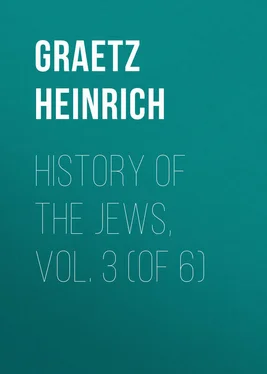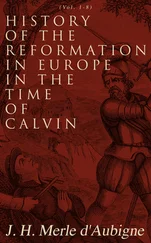Heinrich Graetz - History of the Jews, Vol. 3 (of 6)
Здесь есть возможность читать онлайн «Heinrich Graetz - History of the Jews, Vol. 3 (of 6)» — ознакомительный отрывок электронной книги совершенно бесплатно, а после прочтения отрывка купить полную версию. В некоторых случаях можно слушать аудио, скачать через торрент в формате fb2 и присутствует краткое содержание. Жанр: История, foreign_antique, foreign_prose, на английском языке. Описание произведения, (предисловие) а так же отзывы посетителей доступны на портале библиотеки ЛибКат.
- Название:History of the Jews, Vol. 3 (of 6)
- Автор:
- Жанр:
- Год:неизвестен
- ISBN:нет данных
- Рейтинг книги:3 / 5. Голосов: 1
-
Избранное:Добавить в избранное
- Отзывы:
-
Ваша оценка:
- 60
- 1
- 2
- 3
- 4
- 5
History of the Jews, Vol. 3 (of 6): краткое содержание, описание и аннотация
Предлагаем к чтению аннотацию, описание, краткое содержание или предисловие (зависит от того, что написал сам автор книги «History of the Jews, Vol. 3 (of 6)»). Если вы не нашли необходимую информацию о книге — напишите в комментариях, мы постараемся отыскать её.
History of the Jews, Vol. 3 (of 6) — читать онлайн ознакомительный отрывок
Ниже представлен текст книги, разбитый по страницам. Система сохранения места последней прочитанной страницы, позволяет с удобством читать онлайн бесплатно книгу «History of the Jews, Vol. 3 (of 6)», без необходимости каждый раз заново искать на чём Вы остановились. Поставьте закладку, и сможете в любой момент перейти на страницу, на которой закончили чтение.
Интервал:
Закладка:
It was impossible that Jewish liturgical poetry could long remain satisfied with this simplicity of form. Little by little the Jews became acquainted with the poetry of the Arabs, the agreeable sound of its rhymes captivated them, and they were led to regard rhyme as the perfection of poetry. The poetanists , therefore, if they would be well received, could not afford to neglect this artistic device, and they assiduously devoted themselves to its cultivation. As far as is known, the first poet who introduced rhyme into the neo-Hebraic poetry was a certain Jannai, probably an inhabitant of Palestine. He composed versified prayers for those special Sabbaths which, either by reason of historical events connected with them, or of being a time of preparation for the approaching festivals, were possessed of particular importance. The Agadic discourses, which had been introduced on these Sabbaths, do not seem to have pleased the congregations any longer, because the preachers were unable to find new and attractive matter; they seem, indeed, to have read out the same discourses in a given order from year to year.
The poems of Jannai and his fellow-workers aimed at giving the substance of these Agadic expositions in the form of agreeable verse. Hence, Jannai's productions are versified Agadas. But as he was not enough of a poet to reproduce the elevated and striking passages of Agadic literature, as his rhymes were heavy and labored, and as he also burdened himself with the task of commencing his verses with consecutive letters of the alphabet, and of interweaving his name into them, his poems are dull, clumsy, and unwieldy.
Altogether neo-Hebraic poetry gained nothing during its earlier years by the introduction of rhyme. Eleazar ben Kalir or Kaliri (of Kiriat-Sepher), one of the first and most prolific of the poetanic writers, and a disciple of Jannai, was just as clumsy and harsh as his master, and his style was even more obscure. He wrote over 150 liturgical pieces, including hymns for the festivals, penitential prayers for the holy-days, songs of lamentation for the principal fasts, and various other compositions which cannot be classed under distinct heads. Kaliri put into most artificial verses a large portion of the Agadic literature, but only a few of his compositions have any poetical value, and none possesses beauty. In order to overcome the difficulties which were presented by the allusions to the Agada, by the use of rhyme, of the alphabetically arranged initial words and the interweaving of his name, Kaliri was obliged to do violence to the Hebrew language, to set at defiance the fixed rules which govern the use of words, and to create unprecedented combinations. In place of word-pictures, he often presents to his reader obscure riddles, which it is impossible to solve without a thorough acquaintance with the Agadic writings. Nevertheless, Kaliri's poetic compositions made their way into the liturgies of the Babylonian, Italian, German, and French Jews; the Spaniards alone, guided by delicate feeling for language, refused to adopt them. Kaliri was honored as the greatest of the poetanic writers, and tradition has glorified his name.
By the introduction of these compositions, the liturgy acquired an altered character. The translation of the portions of the Law which were read out to the congregation, and the Agadic expositions thereof, which, as the Jews of the Islamic empire adopted the Arabic language, had become unfamiliar to the multitude, gradually disappeared from the divine service, and their places were filled by metrical compositions (Piyutim) which answered the same purpose, and at the same time possessed the advantage of a poetical character. By this means considerable extension was given to the divine service. The reader supplanted the preacher. Singing was introduced into the synagogue, as the poetical prayers were not recited, but chanted (Chazanuth). Special tunes were introduced for the various prayers. But the poetanic compositions were not adopted by all congregations as part of their divine service. The Talmudical authorities were at first opposed to their adoption, for the reason that they were usually interpolated between the various divisions of the principal prayer, and in this manner destroyed the continuity and coherence of its separate parts.
The return to the source of the Bible had the result of kindling a poetic flame in artistic natures; but, at the same time, it fanned into existence a wild spirit which at first brought trouble, schism, and malediction in its train, although afterwards it became a source of purification, vigor, and blessing to the Jews. The origin of this movement, which divided the Jewish commonwealth of the east and west into two camps, dates from the first Gaonic century.
The Babylonian Talmud held sway over the Jewish community in Babylonia; it was not only a code, but also the constitution for the community of which the Prince of the Captivity and the two presidents of the Talmudical colleges were the chief dignitaries. By the expansion of the Islamic dominion from India to Spain, from the Caucasus far down into Africa, the authority of the Talmud was extended far beyond its original bounds; for the most distant congregations placed themselves into communication with the Geonim, submitted points of religion, morals, and civil law to them for advice, and accepted in full faith their decisions, which were based on the Talmud. The Babylonian-Persian communities felt themselves in nowise hampered by the Talmudical ordinances, which were of their own creation, and had sprung up in their midst, the outcome of their views, morals, and customs, the work of their authorities. The African and European communities were too unlearned in the Bible and the Talmud to be able to express an opinion on the matter. They accepted the decisions of the Geonim as law, without greatly troubling themselves as to their agreement with the Bible.
Not so, however, with the Arabian Jews who had emigrated from Arabia to Palestine, Syria and Irak, the Benu-Kainukaa, the Benu-Nadhir, and the Chaibarites. They were sons of the desert, men of the sword, soldiers and warriors, accustomed from their childhood to a free life and to the development of their strength; men who cultivated social intercourse with their former Arabic allies and fellow-soldiers, in whose midst they again settled after the conquest of Persia and Syria. Judaism was indeed dear to them, for they had sacrificed liberty, country, fame and wealth in its cause, and had resisted Mahomet's importunities, and had not allowed themselves to be converted to Islam. But between the Judaism which they practised in Arabia, and the Judaism taught by the Talmud, and set up as a standard by the colleges, there lay a deep gulf. To conform to Talmudical precepts, it would have been necessary for them to renounce their genial familiarity with their former comrades, and to give up their drinking-bouts with the Arabs which, despite their interdiction by the Koran, the latter greatly loved. In a word, they felt themselves hampered by the Talmud.
The Jews of Arabia, who came into close contact with the Mahometans, and were, therefore, frequently involved in controversy as to whether Judaism was still possessed of authority or had been superseded by Islam, were obliged, so as not to be at a loss in such discussions, to familiarize themselves with the Bible. They in that way probably discovered that much of what the Talmud and the colleges declared to be religious precept, was not confirmed by the Bible. But from whatever cause this aversion to Talmudical precepts may have arisen, it is certain that it first had its origin in the Arabian Jewish colony in Syria or Irak. It is related, in an authentic source, that during the first part of the eighth century, many Jews allowed themselves to be persuaded to abandon Talmudical Judaism and to conform only to the precepts of the Bible.
Читать дальшеИнтервал:
Закладка:
Похожие книги на «History of the Jews, Vol. 3 (of 6)»
Представляем Вашему вниманию похожие книги на «History of the Jews, Vol. 3 (of 6)» списком для выбора. Мы отобрали схожую по названию и смыслу литературу в надежде предоставить читателям больше вариантов отыскать новые, интересные, ещё непрочитанные произведения.
Обсуждение, отзывы о книге «History of the Jews, Vol. 3 (of 6)» и просто собственные мнения читателей. Оставьте ваши комментарии, напишите, что Вы думаете о произведении, его смысле или главных героях. Укажите что конкретно понравилось, а что нет, и почему Вы так считаете.












